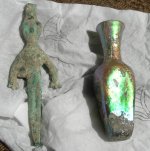C
Casey.R
Guest
I've been comparing the orient on some of my pearls. One of my favorites are the untreated freshwaters I bought from PP during the mothers day special.They have teal colored orient and some pink orient which looks great with the pinkish lavender body of the pearls. My other favorites are some keishis I bought from wats2luv on Ebay. They also have really strong orient too. It's sort of blue rose and green on a cream colored body ( I wonder if they are unbleached?).
Anyway I just bought a strand of the white baroques from PP. First I have to say they are very pretty and a perfect addition to my pearl wardrobe. I really wanted large white baroques since they go with everything, and I had two put on french wires so I could also have earrings . But I have noticed they don't have the same type of orient as the pearls I mentioned above do. Mostly I see pink, but it's not super strong.Could this be from the bleach? Or do certain colors just show secondary colors better than others?
. But I have noticed they don't have the same type of orient as the pearls I mentioned above do. Mostly I see pink, but it's not super strong.Could this be from the bleach? Or do certain colors just show secondary colors better than others?
Anyway I just bought a strand of the white baroques from PP. First I have to say they are very pretty and a perfect addition to my pearl wardrobe. I really wanted large white baroques since they go with everything, and I had two put on french wires so I could also have earrings

